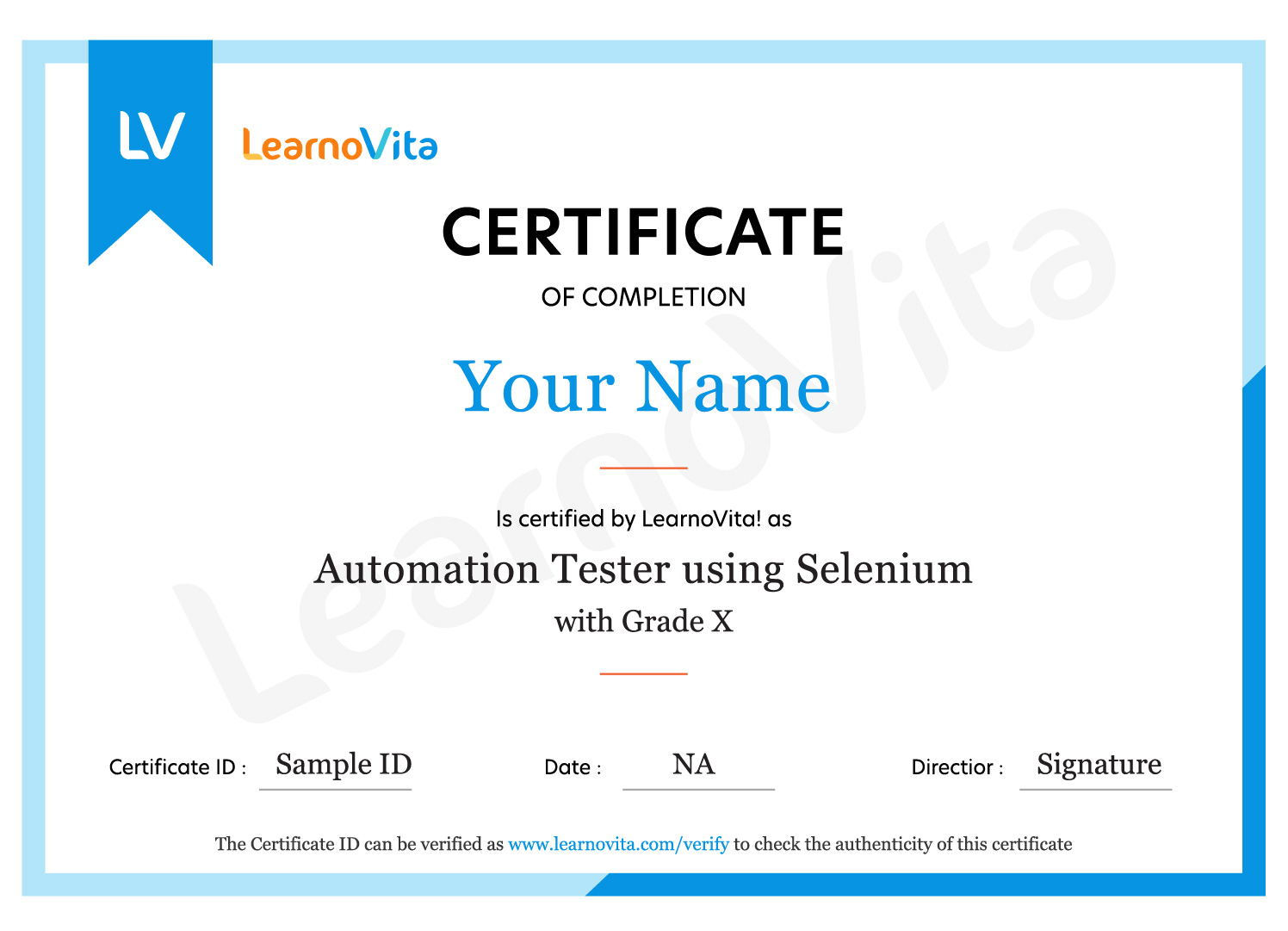An Complete Overview of Maximo Training
Our Maximo Online Training goal is to assist you in becoming proficient with IBM Maximo for workflow automation, asset management, and maintenance. Key components covered in this Maximo course include inventory control, work order management, and advanced reporting. Real-time Maximo Projects provide practical experience. Guidance for Maximo Certification Course is also included in our curriculum to improve your employment possibilities. We provide various learning choices, reasonable Maximo Course Fees, and committed Maximo Placement assistance. To further improve your exposure to the industry and practical experience we also offer a Maximo Internship opportunity. Regardless of your level of experience, this Maximo Online Course will help you develop employable abilities that will help you grow in your career. Take your career to the next level by enrolling today!
Additional Info
Exploring Future Trends in Maximo Training
- AI & Predictive Maintenance:
Asset management is being modified by artificial intelligence (AI), which anticipates equipment breakdowns before they occur. By integrating AI-driven predictive analytics, IBM Maximo optimises maintenance schedules and minimises downtime. Algorithms for machine learning examine past data to predict probable failures. This facilitates the transition of organisations from reactive to proactive maintenance plans. Maximo AI-powered insight improve decision-making in real time. AI will play an increasingly important part in Maximo as it develop.
- Cloud-Based Maximo:
Since cloud-based Maximo solutions offer more flexibility and scalability, many businesses are switching to them Cloud deployment is now possible with IBM Maximo Application Suite (MAS), which lowers infrastructure expenses. Remote accessibility, improved security, and smooth upgrades are made possible with cloud-based Maximo. In the cloud, organisations may more effectively integrate analytics, AI and IoT. Maximo's adoption will be accelerated by the trend towards hybrid and multi-cloud configuration.
- IoT-Enabled Asset Management:
Maximo's real-time asset management and monitoring abilities will be improved by the Internet of Thing. IoT sensors gather information from machinery which aids asset performance optimisation and predictive maintenance. Maximo combines IoT data to deliver automated alerts and actionable insights. This improves overall asset efficiency and lowers unanticipated breakdowns. IoT-driven Maximo solutions are advantageous for sectors including manufacturing, utilities and transportation.
- AR & VR in Maximo:
As they provide immersive training and real-time equipment diagnostics, AR and VR are revolutionising asset maintenance. While doing repairs, technicians can view asset data via AR-enabled smart glasses. Maximo offers digital overlays of maintenance procedures through integration with AR and VR. As a result, worker productivity increases, human error decreases, and safety is improved. AR/VR remote help reduces travel expenses and expedite troubleshooting More AR/VR features will be included in future Maximo releases to improve user experience.
- Blockchain for Asset Tracking:
Blockchain technology being investigated to improve asset management's security and transparency. Blockchain technology can be used by IBM Maximo to track compliance records, maintenance logs, and asset historie. This guards against unwanted changes and guarantees tamper-proof data storage By offering a single source of truth, blockchain increases supply chain management confidence. Maximo solutions enabled by blockchain are advantageous for sectors including manufacturing, energy and logistic. For increased security, future iterations of Maximo might come with integrated blockchain integration.
- Low-Code/No-Code Customization:
Business want to customise Maximo more quickly and easily without needing to know a lot code. Users may construct dashboards, reports, and processes with ease using low-code and no-code platforms. More drag-and-drop capabilities are being added to IBM Maximo to make changes easier. As a result, business users can customise Maximo to meet their needs without relying on IT. Low-code solutions save maintenance expense and speed up implementation Maximo's future growth will be influenced by trend towards user-friendly customisation.
- 5G & Real-Time Maximo:
Maximo will be more prepared for real-time asset data processing as 5G networks proliferate. Remote monitoring, predictive analytics, and IoT sensor integration are all made possible by faster connectivity. Maximo will use 5G to provide real-time asset performance updates, which will speed up decision-making. 5G-powered Maximo deployments will aid sectors including utilities, smart cities, and healthcare. More operational efficiency will result from the integration of 5G, IoT, and Maximo. The impact of 5G on Maximo will increase as it spreads.
- Sustainability & Green Maximo:
Sustainability is becoming a top priority for organisations, and Maximo is changing to facilitate environmentally friendly asset management. Maximo assists in monitoring environmental compliance, carbon footprint, and energy usage. AI-powered insights help minimise waste and maximise energy efficiency. Using Maximo for green asset management encourages sustainable business practices in sectors including manufacturing, transportation, and energy. More sustainability-focused analytics and reporting features will be included in future Maximo versions. Global ESG (Environmental, Social, and Governance) initiatives are in line with this trend.
- Maximo Cybersecurity Enhancements:
Maximo along with other asset management systems need to be secured since cyber threats are growing. Maximo's security features are always being improved by IBM to stop illegal access and data breaches. Real-time threat monitoring, multi-factor authentication, and improved encryption are important advancements. Organisations are using Maximo environments to implement Zero Trust security models. AI-powered security features and compliance automation will be the main topics of future Maximo upgrade Maximo's cybersecurity framework needs to be strengthened in order to safeguard sensitive asset data.
- Maximo in New Industries:
Essentially Maximo is commonly used in utilities and manufacturing, it is also branching out into other industries. Maximo is being adopted by sectors such as smart cities, healthcare, and agriculture for enhanced asset management. Maximo monitors medical equipment compliance and maintenance in the healthcare industry. Maximo is used by smart cities to manage their infrastructure and allocate resources as efficiently as possible. Maximo's flexibility makes it a flexible answer to new demands in the business.
Essential Tools and Techniques of Maximo Training
- Work Order Management:
The Work Order Management application from Maximo facilitates the scheduling, monitoring and administration of maintenance tasks. Work orders for emergencies, corrections, and prevention can be created by users. By giving technicians assignments and monitoring their progress, it optimises workflow. Work order history enhances decision-making and guarantees compliance. Predictive maintenance is made possible by IoT and AI integration This tool minimises downtime and maximises maintenance efficiency.
- Asset Management Module:
Organisations may monitor and manage physical assets at every stage of their lifecycle with the use of this module. It offers thorough asset records including location, maintenance history, and specs. Calculations for asset depreciation and cost analysis are supported by Maximo. By using preventive maintenance techniques users may maximise the functioning of their assets. IoT integration enables real-time asset tracking Lower operating expenses and improved asset utilisation are guaranteed by this solution.
- Inventory Management:
The Inventory Management solution of Maximo ensures effective material tracking and stock control. It facilitates the tracking of stock utilisation reorder points and inventory level. Users are informed about low inventory and the need restocking through automated alerts. Inventory accuracy is increased through the combination of barcodes and RFID. It lowers carrying cost minimising superfluous inventory Maintenance crew are guaranteed to always have appropriate parts on hand thanks to this gadget.
- Procurement & Supply Chain Management:
This program simplifies the entire purchasing process, from managing orders to choosing vendors. Purchase orders, purchase requisitions, and shipment tracking are all available to users. Contract management and vendor performance are facilitated by integration with supplier databases. Workflows that are automated improve approval procedures and cut down on procurement delays. Financial transparency and budget control are guaranteed by cost tracking. This technology aids businesses in streamlining their procurement and supply chain processes.
- Automation Scripts & Workflows:
Maximo facilitates automation scripts that increase productivity and decrease manual labour. Workflows can be created by users to automate escalations, alerts, and approvals. These scripts improve system personalisation without requiring a lot of coding. Workflows that are automated increase adherence to corporate guideline. AI-powered automation lowers errors and improves predictive maintenance. This method increases system efficiency and streamlines operation.
- Maximo Scheduler:
A planning tool called Maximo Scheduler is used to optimise worker scheduling and maintenance. Work orders, labour availability, and asset downtime are all shown graphically Tasks can be assigned by users according to resource availability, skill set and priority. Task management and rescheduling are made easier with drag-and-drop capability. Predictive maintenance scheduling enhanced with AI integration This tool lowers service interruptions and increases worker efficiency.
- Preventive & Predictive Maintenance:
Maximo makes preventative maintenance (PM) possible by planning regular service and inspections. Data analytics is used in predictive maintenance (PdM) to predict equipment fault. Real-time asset condition monitoring is facilitated by IoT and AI integration. These methods prolong the life of assets and decrease unscheduled downtime. Users can specify maintenance triggers according to sensor data, usage or time. In addition to lowering repair costs, predictive and preventive maintenance increases dependability.
- Maximo Mobile:
Maximo Mobile uses tablets and smartphones to give users remote access to asset and work order data. Technicians may browse manuals, take pictures, and amend work orders while they're on the go. Offline mode is supported by the app, guaranteeing uninterrupted work in remote areas. Route optimisation and asset location tracking are made easier with GPS integration Real-time synchronisation enhances cooperation and data accuracy. Field operations and technician productivity are improved by this technology.
- Reporting & Analytics (BIRT & Cognos):
IBM Cognos for reporting and BIRT (Business Intelligence and Reporting Tools) are integrated into Maximo. Custom dashboards and reports can be created by users to support data-driven decision-making. Monitoring worker productivity, maintenance expenses, and asset performance is made easier with the use of advanced analytics. Predictive analytics and trend predictions are improved by integration with AI. Operational transparency and compliance monitoring are enhanced via real-time information Better business insights and well-informed decision-making are guaranteed by this technology.
- Maximo Integration Framework (MIF):
Data sharing with external systems is made easy using the Maximo Integration Framework (MIF) Integration with other enterprise apps such as ERP, CRM and IoT is supported. Using XML-based interfaces, REST, and web services, users can set up integration Across many business platforms, MIF guarantees real-time data synchronisation It improves interoperability and lower errors and human data entry. This solution increases automation and data consistency across the entire organisation.
Key Roles and Responsibilities of Maximo Training
- Maximo Administrator:
The Maximo environment must be configured, maintained, and optimised by a Maximo Administrator. They control system performance, security configurations, and user access. Administrators make ensuring fixes, software updates, and integrations function properly. They work with IT teams to organise improvement and troubleshoot system problem. Database administration and performance monitoring are important dutie They also guarantee adherence to legal and business obligation.
- Maximo Developer:
A Maximo developer adapts and improves Maximo apps to suit business requirements. They create workflows integrations with other systems, and automation scripts. Coders use SQL, Python, and Java to augment Maximo's capabilitie To maximise system performance, they work together with administrators and end users." They are responsible for UI improvements and the creation of custom report. Developers also make ensuring that new features are tested and upgrades go smoothly.
- Maximo Functional Consultant:
A Maximo Functional Consultant analyses business needs and sets up Maximo appropriately. For effective operations, they provide asset hierarchies, workflow, and user role To help users use Maximo efficiently, consultants lead training sessions. They collaborate closely with IT departments to guarantee the smooth implementation of systems. They are responsible for system testing and process optimisation. They serve as a link between technical Maximo solution.
- Maximo Technical Consultant:
Maximo implementation and customization are the areas of expertise for a Maximo Technical Consultant. Work Order Management Inventory, and Asset Management are among the modules they set up. ERP, IoT, and cloud platform system integrations are managed by consultants. They improve database speed and solve complicated technical problem. Creating workflows and automation scripts is a crucial duty. They make sure the system runs smoothly and complements corporate goals.
- Maximo Business Analyst:
Business requirements are collected by a Maximo Business Analyst, who then converts them into Maximo solution Workflows are examined, process enhancements are found, and Maximo is set up appropriately. Stakeholders and analysts work together to make sure the system satisfies organisational requirements. They produce useful reports, training materials, and documentation. Business analysts collaborate with developers to put customisations into practice They guarantee that Maximo complies with regulatory requirements and industry best practices.
- Maximo Support Engineer:
A Maximo Support Engineer fixes system problems and offers end users technical support. They identify issues with performance, integrations, and Maximo apps. To maintain system stability, engineers manage software patches, bug fixes and update. They work together with IT teams to improve the efficiency and dependability of the system. One of their main responsibilities is to troubleshoot and train users. Their objective is to guarantee smooth Maximo operations and reduce downtime.
- Maximo Asset Manager:
Asset lifecycle management with Maximo is managed by a Maximo Asset Manager. They guarantee that physical asset are tracked, maintained, and used appropriately. In order to decrease downtime and increase efficiency, managers examine asset performance data. They employ predictive and preventive maintenance techniques. Budget planning and cost research are important duties for asset acquisition. Their function aids businesses in maximising the lifespan of assets and operational effectiveness.
- Maximo Data Analyst:
A Maximo data analyst collects and analyses Maximo data to produce insight. They use BIRT or IBM Cognos to generate custom reports and dashboards. Businesses use analysts to keep an eye on inventory patterns, maintenance expenses and asset performance. To maximise resource allocation and asset upkeep they employ predictive analytics. A major component of their job is to guarantee the integrity and correctness of the data. Their observations help with both operational and strategic decision-making.
- Maximo System Architect:
Maximo infrastructure is designed and developed for enterprise deployment by a Maximo System Architect. They guarantee the security, high availability, and scalability of the system. Data models, procedures, and platform integrations are defined by architects. By utilising sophisticated configurations and best practices they maximise system performance. One important responsibility is making sure that IT policies and regulatory standards are followed Their responsibility is to guarantee that Maximo functions effectively in intricate business setting.
- Maximo Project Manager:
Maximo implementation projects are managed by a Maximo Project Manager from start to finish. In addition to managing stakeholders, they establish project scope, budgets and timeframe. Business users, consultants, and technical teams are all coordinated by project managers. They guarantee that Maximo deployments are in line with institutional objectives and legal mandate. They are responsible for documentation, quality control, and risk assessment. Under their direction, successful Maximo implementations under budget and schedule restrictions are guaranteed.
Top Companies are Looking for Maximo Professionals
- Accenture:
IBM Maximo is built into the asset management solutions offered by Accenture, a multinational consulting and professional services company. For clients in a variety of industries, they are looking for Maximo-certified specialists to optimise and execute EAM plans. Project managers, developers, and Maximo consultants are among the roles. Accenture places strong emphasis on innovation and provides chances to collaborate with cutting-edge technologie Comprehensive training programs and professional development activities are advantageous to employees. The company's worldwide reach offers a variety of project experiences.
- Deloitte:
Deloitte focusses on improving the operational efficiency of its clients by integrating IBM Maximo into its digital enterprise solutions. Professionals with Maximo certification are sought after for positions like System Architects and Functional Consultants. Workers work on initiatives that combine Maximo with cutting-edge technology AI and the Internet of Thing. With access to a wealth of resources Deloitte provides a collaborative work environment The company encourages ongoing education and career development Being a Deloitte employee exposes you to a wide range of clients in different industries.
- Capgemini:
Capgemini, an innovator in digital transformation, provides asset management solutions through IBM Maximo. For implementation, customisation, and support services, they employ Maximo specialists. Maximo developers, technical consultants, and support engineers are among the positions. Capgemini encourages staff members to experiment with new technologies by cultivating an innovative culture. Clear career growth paths and organised training programs are provided by the organisation. Workers gain industry experience by working on a variety of projects.
- Siemens:
Siemens implements IBM Maximo into its industrial automation and smart infrastructure businesses to improve asset dependability and maintenance. They are looking for experts with Maximo certification for positions like system administrators and asset managers. Workers at Siemens work on projects that integrate AI, IoT, and Maximo technology. The business fosters an innovative and ever-learning culture. Opportunities to collaborate with cross-functional teams on international projects are provided by Siemens. Workers gain from a nurturing atmosphere that prioritises career advancement.
- General Electric (GE):
GE uses IBM Maximo for asset lifecycle management and predictive maintenance in sectors like healthcare, power, and aviation. They employ Maximo experts for positions such as data analysts and solution architects. Workers collaborate on projects that combine machine learning and sophisticated analytics with Maximo. GE offers a vibrant workplace that emphasises technological innovation. Employee skill development and ongoing education are encouraged by the organisation. Exposure to cutting-edge technologies and industry-leading processes is provided by working at GE.
- Tata Consultancy Services (TCS):
TCS hires experts for implementation, customisation, and support roles and provides enterprise asset management services driven by IBM Maximo. Project managers, developers, and Maximo consultants are among the roles available. TCS places a strong emphasis on a customer-centric strategy by giving staff members chances to collaborate closely with customers. The business funds training and development initiatives for its staff Diverse project experiences are made possible by TCS's global presence A cooperative and welcoming workplace culture is advantageous to employees.
- Infosys:
Infosys offers professionals for execution, integration, and support services, and uses IBM Maximo to serve asset-intensive businesses. Technical Leads and Maximo Functional Consultants are among the positions. An atmosphere of innovation and ongoing development is promoted by Infosys. The organisation provides mentorship opportunities and extensive training programs. Workers work on initiatives that maximise client operations by utilising Maximo's capabilities. Exposure to worldwide projects and a variety of sectors is made possible by Infosys' global footprint.
- IBM:
IBM, the company that developed Maximo, has experts working for it to design, implement, and maintain Maximo solutions for customers all over the world. Maximo Product Specialists, Developers, and Support Engineers are among the roles. Being employed at IBM allows one to directly participate in Maximo's continuous innovation and development. The organisation offers a wealth of options for study and career advancement. Workers participate in innovative projects and work together with subject-matter specialists. Opportunities for worldwide experience and collaboration are provided by IBM's global operations.
- Honeywell:
Honeywell wants experts to improve asset performance management by integrating IBM Maximo into its industrial automation and smart building solutions. Maximo System Administrators and Integration Specialists are among the roles available. Workers collaborate on projects that combine building management and IoT systems with Maximo. Honeywell encourages technical innovation and progress To keep staff members abreast of emerging technologies the organisation provides training courses. Working with Honeywell exposes one to a variety of industries and Maximo applications.
- BPD Zenith:
BPD Zenith a top provider of IoT solutions and Maximo deployments, employs experts for positions like Maximo Consultants and Data Analysts. Working with seasoned professionals gives employees practical experience. Opportunities to obtain certifications in data analysis and related topics are provided by the organisation BPD Zenith places a strong emphasis on ongoing education and professional growth Workers collaborate on projects that combine analytics and IoT technologies with Maximo.



















 Regular 1:1 Mentorship From Industry Experts
Regular 1:1 Mentorship From Industry Experts




